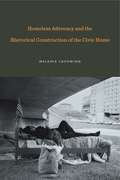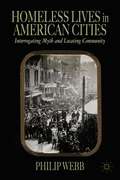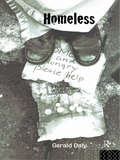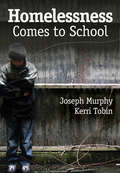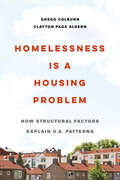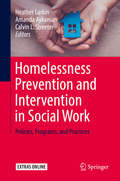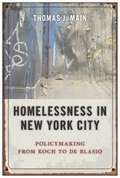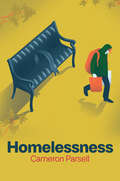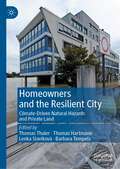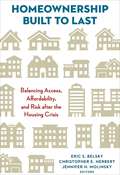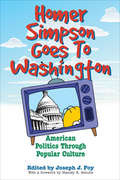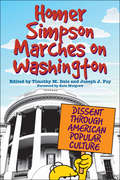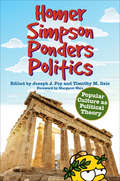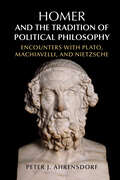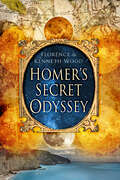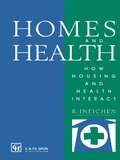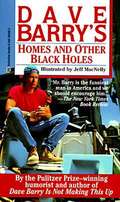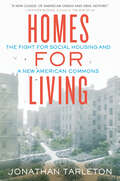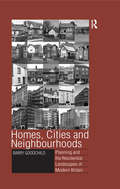- Table View
- List View
Homeless
by Ella HowardThe homeless have the legal right to exist in modern American cities, yet antihomeless ordinances deny them access to many public spaces. How did previous generations of urban dwellers deal with the tensions between the rights of the homeless and those of other city residents? Ella Howard answers this question by tracing the history of skid rows from their rise in the late nineteenth century to their eradication in the mid-twentieth century.Focusing on New York's infamous Bowery, Homeless analyzes the efforts of politicians, charity administrators, social workers, urban planners, and social scientists as they grappled with the problem of homelessness. The development of the Bowery from a respectable entertainment district to the nation's most infamous skid row offers a lens through which to understand national trends of homelessness and the complex relationship between poverty and place. Maintained by cities across the country as a type of informal urban welfare, skid rows anchored the homeless to a specific neighborhood, offering inhabitants places to eat, drink, sleep, and find work while keeping them comfortably removed from the urban middle classes. This separation of the homeless from the core of city life fostered simplistic and often inaccurate understandings of their plight. Most efforts to assist them centered on reforming their behavior rather than addressing structural economic concerns.By midcentury, as city centers became more valuable, urban renewal projects and waves of gentrification destroyed skid rows and with them the public housing and social services they offered. With nowhere to go, the poor scattered across the urban landscape into public spaces, only to confront laws that effectively criminalized behavior associated with abject poverty. Richly detailed, Homeless lends insight into the meaning of homelessness and poverty in twentieth-century America and offers us a new perspective on the modern welfare system.
Homeless Advocacy and the Rhetorical Construction of the Civic Home (Rhetoric and Democratic Deliberation #19)
by Melanie LoehwingHomeless assistance has frequently adhered to the “three hots and a cot” model, which prioritizes immediate material needs but may fail to address the political and social exclusion of people experiencing homelessness. In this study, Loehwing reconsiders typical characterizations of homelessness, citizenship, and democratic community through unconventional approaches to homeless advocacy and assistance.While conventional homeless advocacy rhetoric establishes the urgency of homeless suffering, it also implicitly invites housed publics to understand homelessness as a state of abnormality that destines the individuals suffering it to life outside the civic body. In contrast, Loehwing focuses on atypical models of homeless advocacy: the meal-sharing initiatives of Food Not Bombs, the international competition of the Homeless World Cup, and the annual Homeless Persons’ Memorial Day campaign. She argues that these modes of unconventional homeless advocacy provide rhetorical exemplars of a type of inclusive and empowering civic discourse that is missing from conventional homeless advocacy and may be indispensable for overcoming homeless marginalization and exclusion in contemporary democratic culture.Loehwing’s interrogation of homeless advocacy rhetorics demonstrates how discursive practices shape democratic culture and how they may provide a potential civic remedy to the harms of disenfranchisement, discrimination, and displacement. This book will be welcomed by scholars whose work focuses on the intersections of democratic theory and rhetorical and civic studies, as well as by homelessness advocacy groups.
Homeless Advocacy and the Rhetorical Construction of the Civic Home (Rhetoric and Democratic Deliberation)
by Melanie LoehwingHomeless assistance has frequently adhered to the “three hots and a cot” model, which prioritizes immediate material needs but may fail to address the political and social exclusion of people experiencing homelessness. In this study, Loehwing reconsiders typical characterizations of homelessness, citizenship, and democratic community through unconventional approaches to homeless advocacy and assistance.While conventional homeless advocacy rhetoric establishes the urgency of homeless suffering, it also implicitly invites housed publics to understand homelessness as a state of abnormality that destines the individuals suffering it to life outside the civic body. In contrast, Loehwing focuses on atypical models of homeless advocacy: the meal-sharing initiatives of Food Not Bombs, the international competition of the Homeless World Cup, and the annual Homeless Persons’ Memorial Day campaign. She argues that these modes of unconventional homeless advocacy provide rhetorical exemplars of a type of inclusive and empowering civic discourse that is missing from conventional homeless advocacy and may be indispensable for overcoming homeless marginalization and exclusion in contemporary democratic culture.Loehwing’s interrogation of homeless advocacy rhetorics demonstrates how discursive practices shape democratic culture and how they may provide a potential civic remedy to the harms of disenfranchisement, discrimination, and displacement. This book will be welcomed by scholars whose work focuses on the intersections of democratic theory and rhetorical and civic studies, as well as by homelessness advocacy groups.
Homeless Lives in American Cities: Interrogating Myth and Locating Community
by Philip WebbHomeless Lives in American Cities explores how the American discourse on homelessness arose from Victorian social and political anxieties about the impacts of immigration and urbanization on the middle class family. It demonstrates how contemporary social work and policy emerge from Victorian cultural attitudes.
Homeless: Policies, strategies and Lives on the Streets
by Gerald DalyThe causes of homelessness are disputed by both Right and Left. But, few would argue that life on the streets is anything other than dangerous and debilitating. Unemployment, deinstitutionalisation, abuse in the home are among the stories the homeless tell. Voluntary organisations point to the failure of emergency shelters and food banks, the cut-backs in social programmes and the severe shortage of affordable housing. On the international scale, the changing global system has placed new demands on the economies of Europe and north America which have impacted on resources, employment and even political will. This book is the first comprehensive international study of homelessness. The author argues that the category of the homeless must itself be broadened, to encompass those chronically without shelter to those in immediate risk of dispossession, if homelessness is to be tackled effectively (before and after it happens) by public policy, voluntary organisations and the individuals themselves.
Homelessness Comes to School
by Joseph F. Murphy Kerri J. TobinThe seminal work on homeless students and our responsibility to educate them Homelessness Comes to School provides substantial and far-reaching research that describes the plight of homeless children, the legal framework surrounding the issue, and ways to work together toward a solution. The text also outlines effective intervention programs and includes specific guidelines for teaching homeless students. Topics covered include: A history of homelessness, including its demographic patterns, causes, and impact on society The various programs schools have implemented to address the problem How schools, parents, and external community agencies can work together to educate homeless students
Homelessness Is a Housing Problem: How Structural Factors Explain U.S. Patterns
by Gregg Colburn Clayton Page AldernIn Homelessness Is a Housing Problem, Gregg Colburn and Clayton Page Aldern seek to explain the substantial regional variation in rates of homelessness in cities across the United States. In a departure from many analytical approaches, Colburn and Aldern shift their focus from the individual experiencing homelessness to the metropolitan area. Using accessible statistical analysis, they test a range of conventional beliefs about what drives the prevalence of homelessness in a given city—including mental illness, drug use, poverty, weather, generosity of public assistance, and low-income mobility—and find that none explain the regional variation observed across the country. Instead, housing market conditions, such as the cost and availability of rental housing, offer a far more convincing account. With rigor and clarity, Homelessness Is a Housing Problem explores U.S. cities' diverse experiences with housing precarity and offers policy solutions for unique regional contexts.
Homelessness Prevention and Intervention in Social Work: Policies, Programs, and Practices
by Calvin L. Streeter Heather Larkin Amanda AykanianThis important text provides a comprehensive survey of homelessness in America: its scope and causes, its diverse populations, and the array of responses at the individual, community, and systems levels. Expert contributors explore the links between trauma and homelessness, the cycle of homelessness and health/mental health problems, and barriers preventing people from accessing services. Case studies of effective programs and practices focus on science-based interventions, broad understanding of client needs, and close coordination between systems and agencies. Finally, specialized chapters discuss issues and experiences common to homeless youth and young adults, including housing instability on college campuses and empowerment-based strategies for engaging youth voice in programming . Included in the coverage:Homelessness and health disparities: a health equity lensAffordable housing and housing policy responses to homelessnessStreet talk: homeless discourses and the politics of service provisionMultisectoral collaborations to address homelessnessTrauma-informed care in homelessness service settings: challenges and opportunitiesIncorporating youth voice into services for young people experiencing homelessnessHomelessness Prevention and Intervention in Social Work fills a critical gap in the social work curriculum as a main or a supplementary text. It also makes an accessible resource for clinicians and community practitioners seeking current knowledge on the topic, practical approaches to working with clients experiencing homelessness, and useful information for effective program and policy design.
Homelessness in America: Perspectives, Characterizations, and Considerations for Occupational Therapy
by Kathleen Swenso Miller Georgiana L Herzberg Sharon A RayLearn how to better address the needs of the homelessThe causes of homelessness are complex and varied. Homelessness in America provides an overview of the state of research on the homeless population from an occupation and societal participation perspective. This important resource explores the systems of care in which homeless services are organized, the tailoring of services to meet the needs of diverse types of homeless, the newest trends in services, and crucial funding sources. Research is comprehensively examined from an occupation-based perspective, including studies on specific issues pertaining to various homeless populations. This in-depth discussion provides a vital understanding of homelessness using a client-centered and strengths-based approach in occupational therapy. Much of the research and writings of occupational therapists who work with homeless populations has been scattered throughout various diverse publications. Homelessness in America: Perspectives, Characterizations, and Considerations for Occupational Therapy gathers into one useful volume important insights, practical strategies, and valuable research into the many challenges concerning homelessness. Various effective interventions are discussed in depth. Several leading authorities explore current issues and offer illuminating case studies, extensive reference lists, and helpful tables of funding sources.Topics in Homelessness in America include: results of an Internet-based survey of assessment tools used with the homeless a critical examination of the assumptions of who becomes homeless-and why typologies of homelessness current trends in service delivery federal organization and sources of funding for services exploratory study of occupational concerns and goals of homeless women with children study illustrating the value of the theory of Occupational Adaptation mother-toddler interactions in transitional housing the role of occupational therapy in the youth homelessness problem homeless youths&’ after-school and weekend time use guiding intervention by using the Model of Human Occupation (MOHO) productive role involvement at Project Employ study on life skills interventions with effective recommendations much moreHomelessness in America is insightful, important reading for occupational therapy educators, students, practicing occupational therapists, program directors of services to the homeless, and policymakers.
Homelessness in New York City: Policymaking from Koch to de Blasio
by Thomas J. MainCan American cities respond effectively to pressing social problems? Or, as many scholars have claimed, are urban politics so mired in stasis, gridlock and bureaucratic paralysis that dramatic policy change is impossible? Homelessness in New York City tells the remarkable story of how America’s largest city has struggled for more than thirty years to meet the crisis of modern homelessness through the landmark development, since the initiation of the Callahan v Carey litigation in 1979, of a municipal shelter system based on a court-enforced right to shelter.New York City now shelters more than 50,000 otherwise homeless people at an annual cost of more than $1 billion in the largest and most complex shelter system in the world. Establishing the right to shelter was a dramatic break with long established practice. Developing and managing the shelter system required the city to repeatedly overcome daunting challenges, from dealing with mentally ill street dwellers to confronting community opposition to shelter placement. In the course of these efforts many classic dilemmas in social policy and public administration arose. Does adequate provision for the poor create perverse incentives? Can courts manage recalcitrant bureaucracies? Is poverty rooted in economic structures or personal behavior? The tale of how five mayors—Koch, Dinkins, Giuliani, Bloomberg and de Blasio—have wrestled with these problems is one of caution and hope: the task is difficult and success is never unqualified, but positive change is possible. Homelessness in New York City tells the remarkable story of what happened—for good and sometimes less good—when New York established the right to shelter.
Homelessness: A Critical Introduction
by Cameron ParsellHomelessness is a punishing condition that inflicts unquestionable harm on those who experience it. It is also a social problem that starkly lays bare deep societal failure.As Cameron Parsell shows, society – along with the public policy measures intended to address it – treats being homeless as an identity, casting those who experience homelessness as fundamentally different from “us.” To be homeless is to face daily victimization, to be a recipient of someone else’s care, and to have autonomy taken away. Parsell argues that we have at our disposal the knowledge and momentum to demonstrably reduce and even end homelessness. Our first task is to confront the fact that homelessness is a relatively predictable phenomenon that disproportionately impacts people who are failed by society in myriad ways. We must respond to the problem in ways that understand and thus do not recreate the dehumanizing conditions experienced by those who are homeless. Homelessness is a choice: of how we organize society.Sketching the defining features of homelessness, this critical introduction will be a valuable resource for students studying homelessness, housing, marginality, and poverty across the social sciences and social work.
Homeowners and Neighborhood Reinvestment
by George C. GalsterThis book investigates the efforts of homeowners to maintain and improve their dwellings. Their behavior, it has found, depends on economic variables as well as the sociological structure of their neighborhoods. Residential satisfaction, expectations of the neighborhood, and mobility plans were taken into account. Multivariate statistical analyses of models were conducted using household data from Minneapolis and Wooster, Ohio. Three important findings emerged. First, homeowners' sense of solidarity with their neighbors is as significant in determining their efforts at home upkeep as are their income or age. Second, the optimism of homeowners toward increases in property values results in behavior opposite to that produced by optimism about neighborhood quality of life. This implies that different kinds of predictable gaming behavior occur among homeowners, depending on the neighborhoods in which they live. Third, both short-term and extremely long-term plans to move prove damaging to home upkeep. The results of this study form the basis for a better understanding of such residential phenomena as class succession, racial transition, and gentrification. Galster's findings will also be valuable for analyzing policies that attempt to encourage neighborhood reinvestment.
Homeowners and the Resilient City: Climate-Driven Natural Hazards and Private Land
by Thomas Thaler Thomas Hartmann Lenka Slavíková Barbara TempelsThis book provides an important overview of how climate-driven natural hazards like river or pluvial floods, droughts, heat waves or forest fires, continue to play a central role across the globe in the 21st century. Urban resilience has become an important term in response to climate change. Resilience describes the ability of a system to absorb shocks and depends on the vulnerability and recovery time of a system. A shock affects a system to the extent that it becomes vulnerable to the event. This book focus examines how private property-owners might implement such measures or improve their individual coping and adaptive capacity to respond to future events. The book looks at the existence of various planning, legal, financial incentives and psychological factors designed to encourage individuals to take an active role in natural hazard risk management and through the presentation of theoretical discussions and empirical cases shows how urban resilience can be achieved. In addition, the book guides the reader through different conceptual frameworks by showing how urban regions are trying to reach urban resilience on privately-owned land. Each chapter focuses on different cultural, socio-economic and political backgrounds to demonstrate how different institutional frameworks have an impact.
Homeownership Built to Last
by Eric S. Belsky Christopher E. Herbert Jennifer H. MolinskyThe ups and downs in housing markets over the past two decades are without precedent, and the costs-financial, psychological, and social-have been enormous. Yet Americans overwhelmingly still aspire to homeownership, and many still view access to homeownership as an important ingredient for building wealth among historically disadvantaged groups.This timely volume reexamines the goals, risks, and rewards of homeownership in the wake of the housing bubble and subprime lending crisis. Housing, real estate, and finance experts explore the role of government in supporting homeownership, deliberate how homeownership can be made more sustainable, and discuss how best to balance affordability, access, and risk, particularly for minorities and low income families.Contributors: Eric S. Belsky (JCHS); Raphael W. Bostic (University of Southern California); Mark Calabria (Cato Institute); Kaloma Cardwell (University of California, Berkeley); Mark Cole (Hope LoanPort); J. Michael Collins (University of Wisconsin- Madison); Marsha J. Courchane (Charles River Associates); Andrew Davidson (Andrew Davidson and Co.); Christopher E. Herbert (JCHS); Leonard C. Kiefer (Freddie Mac); Alex Levin (Andrew Davidson and Co.); Adam J. Levitin (Georgetown University Law Center); Mark R. Lindblad (University of North Carolina at Chapel Hill); Jeffrey Lubell (Abt Associates); Patricia A. McCoy (University of Connecticut School of Law); Daniel T. McCue (JCHS); Jennifer H. Molinsky (JCHS); Stephanie Moulton (Ohio State University); john a. powell (University of California-Berkeley); Roberto G. Quercia (University of North Carolina at Chapel Hill); Janneke H. Ratcliffe (University of North Carolina); Carolina Reid (University of California-Berkeley); William M. Rohe (University of North Carolina at Chapel Hill); Rocio Sanchez-Moyano (JCHS); Susan Wachter (University of Pennsylvania); Peter M. Zorn (Freddie Mac)
Homeownership and America's Financial Underclass
by Mechele DickersonWhy does America have a love affair with homeownership? For many, buying a home is no longer in their best interest and may harm their children's educational opportunities. This book argues that US leaders need to re-evaluate housing policies and develop new ones that ensure that all Americans have access to affordable housing, whether rented or owned. After describing common myths, the book shows why the circumstances now faced by America's financial underclass make it impossible for them to benefit from homeownership because they cannot afford to buy homes. It then exposes the risks of 'home buying while brown or black,' discussing US policies that made it easier for whites to buy homes, but harder and more costly for blacks and Latinos to do so. The book argues that remaining racial discrimination and certain demographic features continue to make it harder for blacks and Latinos to receive homeownership's promised benefits.
Homeownership in Hong Kong: House Buying as Hope Mechanism (Routledge Contemporary China Series)
by Chung-kin TsangThis book studies the cultural framework of the connections between homeownership and social stability in Hong Kong. In the post-war period, homeownership became the most preferable housing choice in developed societies, such as Australia, Britain, Japan, Spain, and the United States. In the financialization era, its proliferation aggregated enormous wealth and debt in the housing and mortgage markets, affecting social stability by creating inequality and housing unaffordability. Hong Kong is the most extreme example of this among developed societies – in recent years, the city has made international headlines both for its housing problem and its social instability. By studying the history of homeownership in Hong Kong over a period of four decades, Chung-kin Tsang proposes that homeownership is inseparable from the social imagination of the future, conceptualizing this framework as "hope mechanism". This perspective helps trace the connections between ‘House Buying’ as a hope mechanism – one which is central to subject formation, life goals, and temporal mapping for socially shared life planning – and social stability. Given its unique approach, specifically its use of "hope" as an analytical category, this book will prove to be a useful resource for scholars in economic culture and financialization, and Asian Studies, especially those working on the cultural, sociopolitical, and economic history of Hong Kong.
Homer Simpson Goes To Washington: American Politics Through Popular Culture
by Joseph J. Foy&“Informative and entertaining . . . convincingly argue[s] that an interest in popular culture can counterbalance the growing tide of political apathy.&” —Publishers Weekly While pundits may accuse popular culture of brainwashing, indoctrinating, distracting, or dumbing down the masses, the fact is that Americans have long turned to entertainment sources to make sense of politics, through television shows such as The Simpsons, The West Wing, The Daily Show, and Chappelle&’s Show and films such as Election, Bulworth, and Wag the Dog. In Homer Simpson Goes to Washington, Joseph J. Foy has assembled a multidisciplinary team of scholars with backgrounds in political science, philosophy, law, cultural studies, and music. Their essays tackle common assumptions about government and explain fundamental concepts such as civil rights, democracy, and ethics—through the lens of drama and comedy.
Homer Simpson Marches on Washington: Dissent through American Popular Culture
by Timothy M. Dale and Joseph J. FoyA volume of enlightening essays on how TV shows, movies, and music can change hearts and minds. Amid all its frenetic humor, the long-running animated hit The Simpsons has often questioned what is culturally acceptable, wading into controversial subjects like gay rights, the war on terror, religion, and animal rights. This subtle form of political analysis is effective in changing opinions and attitudes on a large scale. Homer Simpson Marches on Washington explores the transformative power that enables popular culture to influence political agendas, frame the consciousness of audiences, and create profound shifts in values and ideals. To investigate the full spectrum of popular culture in a democratic society, editors Timothy M. Dale and Joseph J. Foy gather a top-notch team of scholars who use television shows such as Star Trek, The X-Files, All in the Family, The View, The Daily Show, and The Colbert Report, as well as movies and popular music, to investigate contemporary issues in American popular culture.
Homer Simpson Ponders Politics: Popular Culture as Political Theory
by Timothy M. DaleWhat pop culture from The Hobbit to The Office reveals about modern politics—from the authors of Homer Simpson Marches on Washington: “Fun and engaging.” —William Irwin, author of Black Sabbath and PhilosophyIt’s said that the poet Homer educated ancient Greece. Joseph J. Foy and Timothy M. Dale have assembled a team of notable scholars who argue, quite persuasively, that Homer Simpson and his ilk are educating America and offering insights into the social order and the human condition.Following Homer Simpson Goes to Washington (winner of the John G. Cawelti Award for Best Textbook or Primer on American and Popular Culture) and Homer Simpson Marches on Washington, this exceptional volume reveals how books like J. R. R. Tolkien’s The Hobbit and J. K. Rowling’s Harry Potter, movies like Avatar and Star Wars, and television shows like The Office and Firefly define Americans’ perceptions of society. The authors expand the discussion to explore the ways in which political theories play out in popular culture.Homer Simpson Ponders Politics includes a foreword by fantasy author Margaret Weis (coauthor/creator of the Dragonlance novels and game world) and is divided according to eras and themes in political thought: The first section explores civic virtue, applying the work of Plato and Aristotle to modern media. Part 2 draws on the philosophy of Hobbes, Locke, Rousseau, and Smith as a framework for understanding the role of the state. Part 3 explores the work of theorists such as Kant and Marx, and the final section investigates the ways in which movies and newer forms of electronic media either support or challenge the underlying assumptions of the democratic order. The result is an engaging read for students as well as anyone interested in popular culture.
Homer and the Tradition of Political Philosophy: Encounters with Plato, Machiavelli, and Nietzsche
by Peter J. AhrensdorfIn this book, Peter Ahrensdorf explores an overlooked but crucial role that Homer played in the thought of Plato, Machiavelli, and Nietzsche concerning, notably, the relationship between politics, religion, and philosophy; and in their debates about human nature, morality, the proper education for human excellence, and the best way of life. By studying Homer in conjunction with these three political philosophers, Ahrensdorf demonstrates that Homer was himself a philosophical thinker and educator. He presents the full force of Plato's critique of Homer and the paramount significance of Plato's achievement in winning honor for philosophy. Ahrensdorf also makes possible an appreciation of the powerful concerns expressed by Machiavelli and Nietzsche regarding that achievement. By uncovering and bringing to life the rich philosophic conversation among these four foundational thinkers, Ahrensdorf shows that there are many ways of living a philosophic life. His book broadens and deepens our understanding of what a philosopher is.
Homer's Secret Odyssey
by Kenneth Wood Florence WoodHomer is renowned as the finest of the storytellers who for countless generations passed down by word of mouth the myths and legends of Ancient Greece. Yet, for some 2500 years there have been persistent folk memories that his genius extended far beyond literature and that scientific knowledge was hidden in his stories of heroes and villains, gods and ghosts, monsters and witches. Research now reveals that at a time when the Greeks did not have a written script, Homer concealed an astonishing range of learning about calendar making and cycles of the sun, moon and planet Venus in the Odyssey, his epic of the Fall of Troy and the adventures of the warrior-king Odysseus.
Homes and Health: How Housing and Health Interact
by Bernard IneichenThis book links where people live with their health. The author reviews how housing has influenced health throughout the past hundred and fifty years, discusses in detail current issues concerning housing and health and describes attempts at housing particular groups whose health is at risk.
Homes and Other Black Holes
by Dave Barry"Mr. Barry is the funniest man in America and we should encourage him."--The New York Times Book ReviewTHERE'S NO PLACE LIKE HOME--EXCEPT IN A SELLER'S MARKETAt long last, Dave Barry, the dean of everything, lets you in on the deepest, darkest mysteries of life and answers your hysterical home purchase questions like they've never been answered before: What's the best way to determine a realistic price range?Take your total family income, including coins that have fallen behind the bureau, and any projected future revenue you have been notified about via personalized letters from Mr. Ed McMahon stating that you may already have won 14 million dollars. Then, multiply by something other than six. Can you recommend a good mortgage?There are several kinds: Fixed Rate, Variable Rate, and the bank's secret weapons, the Party Hat Mortgage and the Mortgage of the Living Dead. How can I avoid spending money on do-it-yourself homeowner's projects?Find a contractor. Their silent motto is "We Never Show Up." The Romans lived among the ruins. You must too. Is there a secret to having a beautiful lawn?Yes and no. If you fail to feed, fertilize, and water your lawn, it will die. However, if you feed, fertilize, and water your lawn, it will die.From the Paperback edition.
Homes for Living: The Fight for Social Housing and a New American Commons
by Jonathan TarletonA tale of 2 NYC affordable housing co-ops&’ struggle over privatization, public goods, and the future of American housingThe American Dream of homeownership is becoming an American Delusion. As renters seek an escape from record-breaking rent hikes, first-time buyers find that skyrocketing interest rates and historically low inventory leave them with scant options for an affordable place to live. With home valued more than ever as a commodity, even social housing programs meant to insulate families from cut-throat markets are under threat—sometimes by residents themselves.In Homes for Living, urban planner and oral historian Jonathan Tarleton introduces readers to 2 social housing co-ops in Brooklyn and Manhattan. Longtime residents of St. James Towers and Southbridge Towers lock horns over whether to maintain the rules that have kept their homes affordable for decades or to cash out at great personal profit, thereby denying future generations the same opportunity to build thriving communities rooted in mutual care.With a deft hand for mapping personal histories atop the greater housing crisis, Tarleton explores housing as a public good, movements for tenant rights and Indigenous sovereignty, and questions of race and class to lay bare competing visions of what ownership means, what homes are for, and what neighbors owe each other.
Homes, Cities and Neighbourhoods: Planning and the Residential Landscapes of Modern Britain
by Barry GoodchildGiven current projections of population and household numbers, housing has become arguably the most important issue in planning. Likewise, planning raises arguably the most important long term issues in housing, given the environmental consequences of urban development and the use of the home. Homes, Cities and Neighbourhoods documents the evolution of typical urban landscapes from 1900 to the present with an emphasis on contemporary issues and practice. In doing this, the book examines in detail: -

